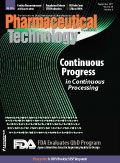Building Toolboxes in Pursuit of Single-Enantiomer Drugs
Biocatalysis, chemocatalysis, and other chiral technologies continue to attract the investment dollars of CMOs and fine-chemical companies.
Technology differentiation is an important strategy in any business sector. It is particularly crucial for fine-chemical producers and contract manufacturers of intermediates and APIs, which face an increasingly competitive market. Strengthening capabilities in biocatalysis, chemocatalysis, and other technologies in support of pharmaceutical companies' interest in producing single-enantiomer drugs is an area of investment by select fine-chemical companies, CMOs, and technology providers.

Patricia Van Arnum
Biocatalysis strength
Biocatalysis is a valued approach in producing intermediates and APIs of desired stereoselectivity. In building their toolboxes, companies are expanding their offerings in biocatalysts through organic growth, industrial partnerships, and academic collaborations. For example, in May 2011, Almac launched its selectAZyme brand of biocatalysts, including reductases, transaminases, hydrolases, and nitrilases for use in synthesizing APIs and fine chemicals, including chiral compounds. The selectAZyme service also provides metabolite synthesis for oxidative and glycosylated products.
The launch of the selectAZyme line of biocatalysts follows Almac's $4-million investment in biocatalysis R&D. Research areas include new biocatalytic platforms for producing chiral intermediates, hyperactivation of biocatalysts for reducing enzyme loadings, developing drivers for cofactor recycling, and mitigating problems with equilibriums. In 2009, the company also launched carbonyl reductase, transaminase, hydrolase, nitrilase, and nitrile hydratase enzyme-screening kits.
As an example of biocatalysis at work, Almac carried out preliminary screening to show that a carbonyl reductase (CRED) bioreduction could replace a resolution for preparing a chiral alcohol. After identifying a CRED at small scale, the company scaled up production and integrated the biocatalytic approach into the API process-development program and manufactured 30 kg for Phase I clinical trials, according to an Almac Oct. 7, 2010, press release.
In December 2010, DSM Pharmaceutical Products, the custom manufacturing organization of DSM, formed a license agreement with c-LEcta, an industrial biotechnology company. The agreement grants DSM rights to c-LEcta's proprietary alcohol dehydrogenases for enzyme-screening programs and for developing manufacturing routes for APIs and intermediates. Alcohol dehydrogenases are used to synthesize chiral alcohols from ketones.
In September 2010, DSM launched InnoSyn, a route-screening service, which applies tools such as biocatalysis, homogeneous catalysis, and continuous chemistry using microreactors to screen catalysts for feasibility studies for chemocatalytic and biocatalytic steps. The company earlier had introduced new enzymes, such as pig liver esterase (i.e., pharmaPLE), lyases, transaminases, dehydrogenases and homogeneous catalysts for asymmetric hydrogenations, aromatic substitutions, and oxidations.
In January 2011, the biocatalysis firm Codexis and DSM Pharmaceutical Products formed an enzyme-supply agreement. The agreement grants DSM rights to use Codexis's custom biocatalysts and services and secures a supply of Codexis enzymes for commercialization of pharmaceutical manufacturing routes developed by DMS's InnoSyn route-scouting service. In October 2010, Codexis expanded its offerings in biocatalysis by introducing screening kits for a subset of the range of biocatalysts it offers. The kits contain 24 enzymes from Codexis's collection of biocatalyst variants from two enzyme classes: ketoreductase and transaminase.
Codexis recently formed several biocatalysis partnerships with pharmaceutical companies. In May 2011, the company successfully completed technology transfer of custom biocatalysts for the manufacture of three undisclosed pharmaceutical products to Teva Pharmaceutical Industries. Two products were transferred to pilot manufacturing, and a third to full-scale commercial manufacturing. The original agreements covering the development of these processes were signed in 2009. In January 2011, Codexis formed a collaboration with Dainippon Sumitomo Pharma (DSP) under which Codexis is supplying biocatalysis screening products and services to DSP for use in selected undisclosed therapeutic products in its development pipeline.
In 2010, researchers at Merck & Co. and Codexis reported on the biocatalytic asymmetric synthesis of chiral amines from ketones in the manufacture of sitagliptin, the active ingredient in Merck's antidiabetes drug Januvia. The biocatalytic process replaced a rhodium-catalyzed asymmetric enamine hydrogenation for the large-scale manufacture of sitagliptin. The researchers started from an (R)-selective transaminase that showed slight activity on a smaller truncated methyl ketone analogue of the sitagliptin ketone. After creating this transaminase, which had marginal activity for the synthesis of the chiral amine, they further engineered the enzyme through directed evolution to optimize its use for large-scale manufacturing (1–3).
The initial (R)-selective transaminase was a homologue of an enzyme from Arthrobacter sp., which previously was used for (R)-specific transamination of methyl ketones and small cyclic ketones. For the sitagliptin synthesis, the researchers generated a structural homology model of this transaminase and found that the enzyme would not bind to the prositagliptin ketone because of steric interference and potentially undesired interactions. The evolved transaminase was a successful biocatalyst that synthesized the chiral amines that previously were accessible only through resolution (1–3).
Codexis and Merck were recognized in 2010 with an Environmental Protection Agency's Presidential Green Chemistry Challenge Award, an annual recognition of advances in green chemistry. Codexis also submitted for consideration in 2010 and 2011 a biocatalytic route for making simvastatin, the active ingredient in Merck & Co.'s anticholesterol drug Zocor, which is now off patent (3, 4).
Codexis licensed technology from Yi Tang, professor in the department of chemical and biomolecular engineering at the University of California at Los Angeles. The previous synthetic routes to simvastatin involved converting lovastatin into simvastatin by adding a methyl group that required protecting and then deprotecting other functionalities in the lovastatin molecule in a multistep synthesis. In the first route, lovastatin was hydrolyzed to the triol, monacolin J, followed by protection with selective silylation, esterification with dimethyl butyryl chloride, and deprotection. The second route involved protecting the carboxylic acid and alcohol functionalities, methylating the C2´ carbon with methyl iodide, and deprotecting the product. These routes were inefficient because they produced less than 70% overall yield and were mass-intensive due to protection and deprotection (3).
The route developed by Tang and his group circumvented protection and deprotection and resulted in greater atom economy, reduced waste, and overall less hazardous reaction conditions. First, they cloned LovD, a natural acyltransferase produced by Aspergillus terreus that is involved in synthesizing lovastatin and that can accept nonnatural acyl donors. Recognizing that LovD might be a type of simvastatin synthase and a starting point for creating a new biocatalytic process, they evolved the enzyme toward commercial utility (3–5). Codexis licensed Tang's technology, engineered the enzyme further, and optimized the process for pilot-scale simvastatin manufacture. During 2010, Codexis scaled up enzyme manufacture to the 150-kg batch scale and manufactured simvastatin ammonium salt in 400-kg batches (4).
In June 2011, the biocatalysis company Enzymicals launched a screening kit for (R)-selective transaminases. Techniques for the recombinant production of (R)-selective transaminases were developed under a collaboration with Lonza. The enzymes can be used in the synthesis of chiral amines and other chiral intermediates. Process patents for transamination also are included in the license agreement, which allows Enzymicals to carry out customer-oriented laboratory testing. Enzymicals was founded in August 2009 by the research group of Uwe Bornscheuer, professor in the department of biotechnology and enzyme catalysis in the Institute of Biochemistry at Ernst Moritz Arndt University in Greifswald, Germany. In addition to (R)-selective transaminases, Enzymicals also offers other proprietary biocatalysts, such as PLE isoenzymes, several esterases, and Baeyer–Villiger-monooxygenases.
In November 2010, W.R. Grace completed its $19.2-million acquisition of Synthetech, a manufacturer of fine chemicals, specialty amino acids, and chiral intermediates, including capabilities in biocatalysis. W.R. Grace acquired Synthetech's prodction and R&D facility in Albany, Oregon, and a second R&D facility in San Diego.
In July 2010, Johnson Matthey acquired X-Zyme, a provider of enzymes, particularly oxidoreductases for producing chiral intermediates. X-Zyme is a 2001 spin-off from Heinrich Heine University's Institute of Molecular Enzyme Technology in Germany. X-Zyme's portfolio included enzymatic catalysts for scalable production of highly pure chiral amines and alcohols. And in March 2010, Cambrex acquired IEP, an industrial biocatalysis company in Wiesbaden, Germany. Cambrex gained IEP's capabilities in customized biocatalytic process-development and enzymes for pharmaceutical applications.
Expansion mode
Other companies also are expanding their capabilities in chiral chemistry. In April 2011, the custom pharmaceutical services business of Dr. Reddy's Laboratories opened a new 33,000-ft2 Chirotech Technology Center in Cambridge, United Kingdom. The additional capacity will facilitate an initial doubling of scientific staff and allow for further capacity additions, including capabilities in biocatalysis and chemocatalysis. In another development in 2010, Sigma Aldrich partnered with BASF to sell BASF's ChiPros branded chiral molecules in small quantities of up to one kilogram. The partnership involves 80 products, including chiral amines, alcohols, epoxides, and acids.
In a reorganization announced in August 2011, Evonik is combining its custom manufacturing business (i.e., exclusive synthesis) with its businesses for pharmaceutical amino acids (i.e., Rexim product line) and pharmaceutical polymers in a new healthcare business line, effective Sept. 1, 2011. The company's exclusive-synthesis business includes capabilities in biocatalysis and chemocatalysis, and the pharmaceutical amino acid business includes natural and nonnatural amino acids for making chiral building blocks.
Tools for molecular characterization and chiral separations also play an important role in producing single-enantiomer drugs. Recent activity includes a collaboration, announced in July 2011, between Chiral Technologies, a provider of chiral separation products, and BioTools, a provider of instrumentation for vibrational chiroptical spectroscopy. Vibrational circular dichroism (VCD) technology is used in structural characterization of chiral drugs and biopharmaceuticals. BioTools manufactures and sells VCD spectrometers, which are used to determine the absolute configuration of single enantiomers.
In December 2010, BioTools, Ghent University in Belgium, and the University of Antwerp opened the European Center for Chirality. The center's mission is to help academic and industrial scientists develop chirality-related applications by offering services ranging from the determination of absolute chiral configurations, vibrational optical activity (VOA) measurements, and computational modeling by providing expert consultants, educational workshops, and open-access VOA instrumentation.
In chromatographic applications, in May 2011, Chiral Technologies launched a new immobilized chiral stationary phase, Chiralpak ID, the fourth addition to the company's product line of immobilized chiral stationary phases. It can be used in high-performance liquid chromatography and supercritical fluid chromatography.
In September 2010, the European operations of Chiral Technologies, Chiral Technologies Europe, entered into a global licensing agreement with the University of Vienna under which Chiral Technologies Europe acquired exclusive manufacturing and marketing rights for Cinchona alkaloid-based zwitterion-exchange type chiral stationary phases invented and developed by researchers at the University of Vienna. The zwitterion-exchange type chiral separation phases separate a broad range of ionizable chiral analytes, which range from acidic and basic molecules to zwitterionic molecules that bear basic and acidic moieties in the same molecule.
Patricia Van Arnum is a senior editor at Pharmaceutical Technology, 485 Route One South, Bldg F, First Floor, Iselin, NJ 08830 tel. 732.346.3072, pvanarnum@advanstar.com.
References
1. P. Van Arnum, Pharm. Technol. 34 (8) 42–44 (2010).
2. C.K. Savile et al., Science 329 (5989), 305–309 (2010).
3. EPA, "The Presidential Green Chemistry Challenge Awards Program: Summary of 2010 Award Entries and Recipients" (Washington, DC, 2010).
4. EPA, "The Presidential Green Chemistry Challenge Awards Program: Summary of 2010 Award Entries and Recipients" (Washington, DC, 2011).
5. Y. Tang, Science 326 (5952), 589–592 (2009).

Drug Solutions Podcast: A Closer Look at mRNA in Oncology and Vaccines
April 30th 2024In this episode fo the Drug Solutions Podcast, etherna’s vice-president of Technology and Innovation, Stefaan De Koker, discusses the merits and challenges of using mRNA as the foundation for therapeutics in oncology as well as for vaccines.